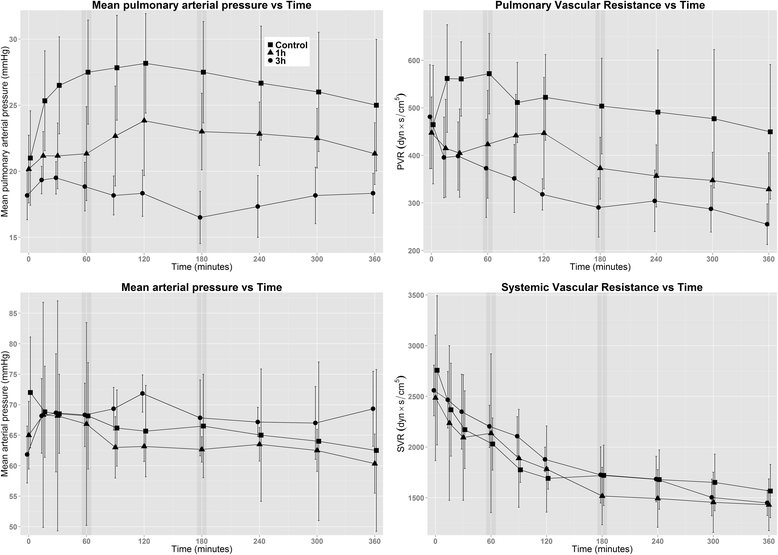THAM reduces CO2-associated increase in pulmonary vascular resistance - an experimental study in lung-injured piglets
- PMID: 26376722
- PMCID: PMC4573471
- DOI: 10.1186/s13054-015-1040-4
THAM reduces CO2-associated increase in pulmonary vascular resistance - an experimental study in lung-injured piglets
Abstract
Introduction: Low tidal volume (VT) ventilation is recommended in patients with acute respiratory distress syndrome (ARDS). This may increase arterial carbon dioxide tension (PaCO2), decrease pH, and augment pulmonary vascular resistance (PVR). We hypothesized that Tris(hydroxymethyl)aminomethane (THAM), a pure proton acceptor, would dampen these effects, preventing the increase in PVR.
Methods: A one-hit injury ARDS model was established by repeated lung lavages in 18 piglets. After ventilation with VT of 6 ml/kg to maintain normocapnia, VT was reduced to 3 ml/kg to induce hypercapnia. Six animals received THAM for 1 h, six for 3 h, and six serving as controls received no THAM. In all, the experiment continued for 6 h. The THAM dosage was calculated to normalize pH and exhibit a lasting effect. Gas exchange, pulmonary, and systemic hemodynamics were tracked. Inflammatory markers were obtained at the end of the experiment.
Results: In the controls, the decrease in VT from 6 to 3 ml/kg increased PaCO2 from 6.0±0.5 to 13.8±1.5 kPa and lowered pH from 7.40±0.01 to 7.12±0.06, whereas base excess (BE) remained stable at 2.7±2.3 mEq/L to 3.4±3.2 mEq/L. In the THAM groups, PaCO2 decreased and pH increased above 7.4 during the infusions. After discontinuing the infusions, PaCO2 increased above the corresponding level of the controls (15.2±1.7 kPa and 22.6±3.3 kPa for 1-h and 3-h THAM infusions, respectively). Despite a marked increase in BE (13.8±3.5 and 31.2±2.2 for 1-h and 3-h THAM infusions, respectively), pH became similar to the corresponding levels of the controls. PVR was lower in the THAM groups (at 6 h, 329±77 dyn∙s/m(5) and 255±43 dyn∙s/m(5) in the 1-h and 3-h groups, respectively, compared with 450±141 dyn∙s/m(5) in the controls), as were pulmonary arterial pressures.
Conclusions: The pH in the THAM groups was similar to pH in the controls at 6 h, despite a marked increase in BE. This was due to an increase in PaCO2 after stopping the THAM infusion, possibly by intracellular release of CO2. Pulmonary arterial pressure and PVR were lower in the THAM-treated animals, indicating that THAM may be an option to reduce PVR in acute hypercapnia.
Figures



Similar articles
-
Experimental high-volume hemofiltration with predilutional tris-hydroxymethylaminomethane for correction of low tidal volume ventilation-induced acidosis.Artif Organs. 2011 Jun;35(6):E108-18. doi: 10.1111/j.1525-1594.2011.01204.x. Epub 2011 May 30. Artif Organs. 2011. PMID: 21623840
-
THAM administration reduces pulmonary carbon dioxide elimination in hypercapnia - an experimental porcine study.Acta Anaesthesiol Scand. 2018 Jul;62(6):820-828. doi: 10.1111/aas.13097. Epub 2018 Mar 12. Acta Anaesthesiol Scand. 2018. PMID: 29532468
-
The treatment of acidosis in acute lung injury with tris-hydroxymethyl aminomethane (THAM).Am J Respir Crit Care Med. 2000 Apr;161(4 Pt 1):1149-53. doi: 10.1164/ajrccm.161.4.9906031. Am J Respir Crit Care Med. 2000. PMID: 10764304
-
Guidelines for the treatment of acidaemia with THAM.Drugs. 1998 Feb;55(2):191-224. doi: 10.2165/00003495-199855020-00003. Drugs. 1998. PMID: 9506241 Review.
-
Effects of hypercapnia and hypercapnic acidosis on attenuation of ventilator-associated lung injury.Minerva Anestesiol. 2011 Jul;77(7):723-33. Minerva Anestesiol. 2011. PMID: 21709659 Review.
Cited by
-
Acute cor pulmonale in patients with acute respiratory distress syndrome: A comprehensive review.World J Crit Care Med. 2021 Mar 9;10(2):35-42. doi: 10.5492/wjccm.v10.i2.35. eCollection 2021 Mar 9. World J Crit Care Med. 2021. PMID: 33728264 Free PMC article. Review.
-
Neuraxial anesthesia for patients with severe pulmonary arterial hypertension undergoing urgent open abdominal surgeries: two case reports.JA Clin Rep. 2024 Sep 2;10(1):52. doi: 10.1186/s40981-024-00737-w. JA Clin Rep. 2024. PMID: 39222132 Free PMC article.
References
-
- Weber T, Tschernich H, Sitzwohl C, Ullrich R, Germann P, Zimpfer M, et al. Tromethamine buffer modifies the depressant effect of permissive hypercapnia on myocardial contractility in patients with acute respiratory distress syndrome. Am J Respir Crit Care Med. 2000;162:1361–5. doi: 10.1164/ajrccm.162.4.9808092. - DOI - PubMed
Publication types
MeSH terms
Substances
LinkOut - more resources
Full Text Sources
Other Literature Sources
Research Materials

